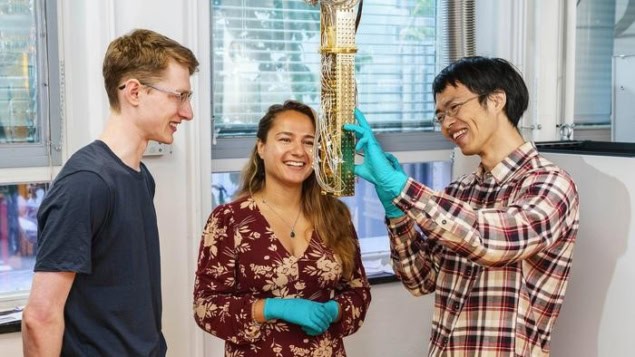
A quantum computing system that uses the spins of holes in germanium quantum dots has been unveiled by researchers in the Netherlands. Their platform is based on a 1998 proposal by two pioneers of quantum computation theory and could offer significant advantages over today’s technologies.
Today, the leading platforms for quantum bits (qubits) are superconducting quantum circuits and trapped ions, with neutral atoms trailing slightly behind. However, all of these qubits are difficult to scale-up and integrate to create practical quantum computers. For example IBM’s Condor – perhaps today’s most powerful quantum computer – uses 1121 superconducting qubits. These must all be kept at millikelvin temperatures, and as the number of qubits grows towards the tens of thousands or even millions, the energy cost and engineering challenges of keeping processors cold become daunting. Other platforms present other scaling challenges that are as significant.
Quantum dot qubits were proposed in 1998 by Daniel Loss of the University of Basel and David DiVicenzo, then at IBM. The qubit state is defined by the quantum state of a single charge on a semiconductor quantum dot, and shuttling the charge between quantum dots allows quantum gate operations to be performed. These systems would need less cooling, and they could potentially be fabricated in semiconductor foundries.
Quantum well
Menno Veldhorst of QuTech in the Netherlands, who co-led this latest research, describes the architecture of the quantum dots. “First, we have a semiconductor heterostructure,” he explains, “This is layers of silicon, silicon–germanium and germanium in our case. And then we have a 2D sheet of germanium, which is the quantum well that we’re interested in. We can confine charges in that 2D sheet, which is maybe 60 nm thick. And then we have electric gates on top so that, if we apply a voltage to those gates, we can define a potential well in which single charges can be trapped.”
In principle, this is a very attractive design, creating a transistor that is a qubit. In practice, however, it has been very difficult to achieve. Loss and DiVicenzo originally envisaged a series of adjacent quantum dots, all subject to different magnetic fields.
“If you have two quantum dots and you put a charge in one of them it will go to its ground state,” says Veldhorst. “If I want to do a qubit operation, say rotating the spin, I can flip it to another quantum dot. But in the other quantum dot, the ground state will be pointing in a different direction. What happens as a result is that the qubit starts to make oscillations as it precesses around this new quantization axis. If I wait a certain amount of time and then pop back to the original dot, I may have flipped the spin state completely.” This procedure would allow arbitrary qubit rotations to be performed with simple applied voltages.
The challenge is creating different magnetic fields on adjacent quantum dots. For the past two decades groups such as Veldhorst’s have applied high-frequency oscillating external magnetic fields to manipulate the spins of electrons, usually in silicon, as they move between quantum dots. These fields increase the power requirements and add noise.
Spin-orbit interaction
In the new work Veldhorst and colleagues looked at Loss’s idea of using holes – quasiparticles created by the absence of electrons – instead of electrons. Like electrons, holes have an energetic coupling to an external magnetic field, giving rise to two distinct energy levels that can create a qubit. However, holes have a much stronger spin-orbit interaction, in which the momentum of the hole is coupled to its spin. Furthermore, this interaction varies between quantum dots.

Controllable quantum dot array breaks size record
The team used holes in their germanium quantum dots. By simply applying a static magnetic field of 40 mT and megahertz-frequency electric fields, the researchers were able to execute quantum logic with single-qubit gate fidelities of 99.97% and two-qubit gate fidelities of 99.3%. Their principal problem today is that they cannot control the anisotropy of the quantum dots. Veldhorst explains that researchers normally try to make quantum dots perfect circles, and their next step will be to make them slightly elliptical to introduce this anisotropy. “This is another thing that, on paper, sounds nice, but whether it will be the case we don’t know,” he says; “But I think we’ve opened a new direction of research with a lot of possibilities.”
Theorist Edwin Barnes of Virginia Tech in the US believes the work is, “a pretty major advance in this area of quantum computing. In the past 20 years people have focused on applying microwaves to perform operations on the qubits, rather than doing this hopping which was in Loss and DiVicenzo’s original paper. In this recent [work] they’re showing that this hopping idea works, and that it seems to work extremely well.” He believes the stochastic variation of the magnetization between quantum dots should not prove insurmountable, as “it just means you just have to spend longer characterizing your device before you start using it”. The next step, he believes, is scaling up.
The research is described in Science and Nature Communications.



